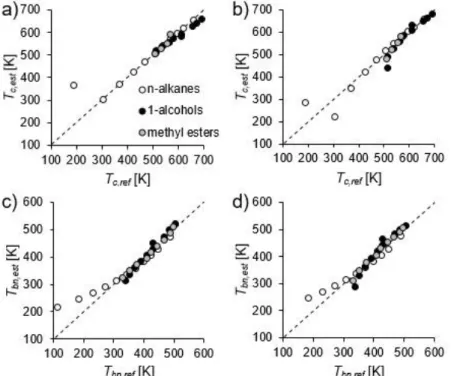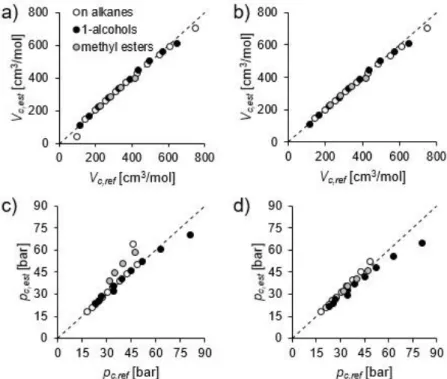corresponding author: Dávid Csemány, csemany@energia.bme.hu
Evaluation of material property estimating methods of n-al- kanes, primary alcohols, and methyl esters
Dávid Csemány, István Gujás, Viktor Józsa
Budapest University of Technology and Economics, Faculty of Mechanical Engineering, Department of Energy Engineering, 1111 Budapest, Műegyetem rkp. 3, Hungary
Introduction
Nowadays, the energy and transportation sector of the world is highly dependent on combustion systems. As the energy demand is continuously increasing, to meet the latest pollutant emission standards and provide an efficient operation, combustion engineers need to cope with several difficulties such as efficient combustion of liquid fuels. In this case, the generated droplets via atomization need to be evaporated and mixed with combustion air before the flame front to ensure low pollutant emission. In order to determine the proper combustion chamber design, the evaporation process, namely the heat and mass transfer between the spray and the environment must be analyzed by computational methods [1,2]
and validated by experiments [3,4]. To solve the relating equations, the following material properties should be known: specific heat capacity, thermal conductivity, density, and viscosity for liquid and gas phases as well, and boiling and critical parameters [5]. The above-mentioned list of properties is mostly available in databases which is often incomplete or its range of validity is limited. Therefore, often estimating methods must be used in order to determine the desired property, and hence calculate liquid evaporation. There are several techniques available in the literature [6] with varying precision for different materials which requires validation. In this manner, general recommendations can be made concerning the estimation of a material property for different materials that can be useful when measurement data is unavailable.
Materials and methods
In order to obtain reliable data, material properties from NIST database were used as reference values at atmospheric pressure [7]. Homologous series of n-alkanes from methane to dodecane, except for undecane, primary alcohols from methanol to decanol, and methyl esters from methyl ethanoate to methyl decanoate were investigated, and their estimated properties were evaluated versus reference data.
The applied estimation methods can be divided into two main groups. One is the Law of Corresponding States (LCS) and the other is the Group Contribution Method (GCM) [6].
According to LCS, the equilibrium properties depending on certain intermolecular forces are related to the critical properties. Pressure, volume and temperature can be expressed as reduced values dividing by the corresponding critical properties. The function relating these reduced properties becomes identical for all fluids. Principally, LCS is appropriate for simple molecules. However, improved accuracy can be reached by adding extra parameters which characterize the molecular orientation, such as acentric factor for weakly, or dipole moment for strongly polar molecules. The law is commonly modified in order to improve applicability. Structure and bonds between atoms are of primary importance concerning intermolecular forces, therefore, macroscopic properties are related to molecular structure.
Thus, with the GCM, a macroscopic property can be estimated from group contributions.
Weighting factors are assigned to atoms, functional groups, and bond types and their
SMARTCATs COST Action CM1404
2
contributions are summed. This method usually contributes to an empirical formula as a correction factor.
Reference data was available for critical properties, normal boiling point temperature and specific heat capacity for liquid and vapor phase for all three types of fluids. Thermal conductivity, density and viscosity for liquid and vapor phase could only be obtained for n- alkanes. However, the amount of reference data proved to be enough to test and evaluate the estimation methods.
Results and discussion
The applied estimation methods are detailed in [6]. GCM of Joback and Constantinou was tested against reference data for critical properties and normal boiling point temperature, shown in Figs. 1 and 2. Method of Constantinou provided poor estimation for methane for Tbn, Vc, and pc, therefore the corresponding values were excluded from the figures.
Generally, the accuracy of both methods increases with increasing the length of carbon chain. Overall, method of Joback is suitable for all the investigated fluids, however method of Constantinou provided better estimation of pc for methyl esters.
Fig. 1. Comparison of critical temperature (a, b) and normal boiling point temperature (d, d) with reference data by using the method of Joback (a, c) and Constantinou (b,d).
Fig. 3. shows the specific heat capacity for vapor and liquid phases. For vapor phase, GCM of Joback and Constantinou were compared, excluding methane, which showed significant deviation from reference data for both methods. Specific heat capacity of methanol vapor could not be estimated properly by either method at low temperatures, because the ideal gas approximation is invalid in that range. Method of Constantinou significantly overestimates cp,v for methyl esters, therefore, method of Joback is recommended. For liquid phase specific heat capacity, a LCS method and a GCM of Ruzicka and Domalski were compared. LCS provided highly inaccurate approximation for methane and methanol, thus those values were omitted in Fig. 3. Both methods provided an appropriate estimation for n-alkanes, however, results of GCM agree better with reference
1st International Conference on Smart Energy Carriers Napoli, 2019
3
data in the case of 1-alcohols and methyl esters. Consequently, method of Ruzicka and Domalski is recommended.
Other properties were only available for n-alkanes, therefore, the evaluation is confined to them. GCM of Elbro estimated liquid density well, except for methane. Vapor density can be approximated with ideal gas law, even for long carbon chains at high temperature. LCS method of Lucas proved to be accurate for vapor viscosity. LCS method of Chung and the modified Eucken method gave excellent estimation for vapor thermal conductivity. For liquid thermal conductivity, GCM of Sastri provided acceptable agreement with reference data, however, the method is only accurate at moderate temperatures.
Fig. 2. Comparison of critical volume (a, b) and critical pressure (c, d) with reference data for method of Joback (a, c) and Constantinou (b, d).
SMARTCATs COST Action CM1404
4
Fig. 3. Comparison of vapor (a, b) and liquid (c, d) specific heat capacity with reference data for method of Joback (a), Constantinou (b), LCS (c) and method of Ruzicka and
Domalski (d).
Conclusions
Literature provides a number of estimation techniques for calculating material properties of various liquids. However, these methods are not universal concerning type of fluids and temperature range. The above-mentioned methods were evaluated and tested against reference data, thus general recommendations could be made concerning their applicability.
Overall, GCM of Joback is suitable for estimating critical properties, normal boiling point temperature and specific heat capacity for vapor phase. For liquid phase specific heat capacity GCM of Ruzicka and Domalski is recommended. Based on reference data for n- alkanes GCM of Elbro for liquid and ideal gas law for vapor density are suitable for application. Furthermore, LCS method of Lucas estimates vapor viscosity properly.
Considering thermal conductivity, LCS method of Chung and modified Eucken method for vapor phase and GCM of Sastri for liquid phase are recommended.
Acknowledgements
This work has been supported by National Research, Development and Innovation Fund of Hungary project № OTKA-FK 124704, New National Excellence Program of the Ministry of Human Capacities project № ÚNKP-18-4-BME-195 and № ÚNKP-18-3-I- BME-145, and the János Bolyai Research Scholarship of the Hungarian Academy of Sciences.
References
[1] A.H. Lefebvre and V.G. McDonell, Atomization and Sprays, Second Edition, CRC Press, Taylor & Francis Group, Boca Raton, 2017.
[2] S. Sazhin, Droplets and Sprays, 2014. doi:10.1007/978-1-4471-6386-2.
[3] P.A. Strizhak, R.S. Volkov, G. Castanet, F. Lemoine, O. Rybdylova and S.S. Sazhin, Heating and evaporation of suspended water droplets: Experimental studies and modelling, Int. J. Heat Mass Transf. 127 (2018) 92–106.
doi:https://doi.org/10.1016/j.ijheatmasstransfer.2018.06.103.
[4] H. Nomura, T. Murakoshi, Y. Suganuma, Y. Ujiie, N. Hashimoto and H. Nishida, Microgravity experiments of fuel droplet evaporation in sub- and supercritical environments, Proc. Combust. Inst. 36 (2017) 2425–2432.
doi:https://doi.org/10.1016/j.proci.2016.08.046.
[5] D. Csemány and V. Józsa, Fuel Evaporation in an Atmospheric Premixed Burner:
Sensitivity Analysis and Spray Vaporization, Process. . 5 (2017).
doi:10.3390/pr5040080.
[6] B.E. Poling, J.M. Prausnitz and J.P. O’Connell, The Properties of Gases and Liquids, 5th Edition, McGraw-Hill, New York, NY, USA, 2001.
[7] E.W. Lemmon, M.O. McLinden and D.G. Friend, Thermophysical Properties of Fluid Systems, NIST Chemistry WebBook, NIST Standard Reference Database Number 69. doi:doi:10.18434/T4D303.

